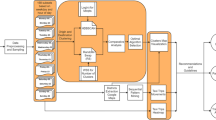Abstract
Many organisations need to extract useful information from huge amounts of movement data. One example is found in maritime transportation, where the automated identification of a diverse range of traffic routes is a key management issue for improving the maintenance of ports and ocean routes, and accelerating ship traffic. This paper addresses,in a first stage,the research challenge of developing an approach for the automated identification of traffic routes based on lusteringmotion vectors rather thanreconstructed trajectories.The immediate benefit of the proposed approach is to avoid the reconstruction of trajectoriesin terms of their geometric shape of the path, their position in space, their life span, and changes of speed, direction and other attributes over time.For clustering the moving objects, an adapted version of the Shared Nearest Neighbour algorithm is used. The motion vectors, with a position and a direction, are analysed in order to identify clusters of vectors that are moving towards the same direction. These clusters represent traffic routes and the preliminary results have shown to be promisingfor the automated identification of traffic routes with different shapes and densities, as well as for handling noise data.
Access this chapter
Tax calculation will be finalised at checkout
Purchases are for personal use only
Preview
Unable to display preview. Download preview PDF.
Similar content being viewed by others
References
Bhavsar, H. and Jivani, A. (2009) The Shared Nearest Neighbor Algorithm with Enclosures (SNNAE), Proceedings of the 2009 WRI World Congress on Computer Science and Information Engineering, IEEE, pp. 436-442.
Bouguessa, M. (2011) A Practical Approach for Clustering Transaction Data, Proceeding of the 7th International Conference on Machine Learning and Data Mining, New York, August/September, LNAI 6871, Springer-Verlag.
Chen, L., Özsu, M. and Oria, V. (2005) Robust and fast similarity search for moving object trajectories, Proceedings of the 2005 ACM SIGMOD international conference on Management of data - SIGMOD’05, ACM Press, New York, New York, USA.
Ertoz, L., Steinbach, M. and Kumar, V. (2002) Finding Clusters of Different Sizes, Shapes, and Densities in Noisy, High Dimensional Data, Proceedings of the Second SIAM International Conference on Data Mining, San Francisco.
Giannotti, F., Nanni, M., Pedreschi, D., and Pinelli, F. (2007) Trajectory Pattern Mining, Proceedings of the Knowledge Discovery in Databases (KDD’07) Conference, San Jose, pp. 330-339.
Giannotti, F. and Pedreschi, D. (2008) Mobility, Data Mining and Privacy: A Vision of Convergence. In: Giannotti, F. and Pedreschi, D. (Eds.): Mobility, Data Mining and Privacy, Springer-Verlag, pp. 1-11.
Grabmeier, J. (2002) Techniques of Cluster Algorithms in Data Mining, Data Mining and Knowledge Discovery, 6(4), pp. 303-360.
Jarvis, R. and Patrick, E. (1973) Clustering Using a Similarity Measure Based on Shared Near Neighbors, IEEE Transactions on Computers, C-22(11), pp. 1025-1034.
Lee, J.-G., Han, J. and Whang, K.-Y. (2007) Trajectory Clustering: A Partition-and-Group Framework, Proceedings of SIGMOD Conference (SIGMOD’07), Beijing, pp. 593-604.
Little, J. J. and Gu, Z. (2001) Video retrieval by spatial and temporal structure of trajectories, Proceedings of SPIE, The International Society for Optical Engineering, pp. 545-552.
Meratnia, N. and de By, R. A. (2002) Aggregation and comparison of trajectories, Proceedings of the 10th ACM international symposium on Advances in Geographic Information Systems, ACM, pp. 49–54.
Miller, H. J. and Han, J. (2009) Geographic Data Mining and Knowledge Discovery, 2nd edition, Taylor & Francis Group.
Perez, H. M., Chang, R., Billings, R., and Kosub, T. L. (2009) Automatic Identification Systems (AIS) Data Use in Marine Vessel Emission Estimation, Presented at the 18th Annual International Emission Inventory Conference. Baltimore.
Rinzivillo, S., Pedreschi, D., Nanni, M., Giannotti, F., Andrienko, N., and Andrienko, G. (2008) Visually driven analysis of movement data by progressive clustering, Information Visualization, 7, pp. 225-239.
Vlachos, M., Kollios, G. and Gunopulos, D. (2002) Discovering similar multidimensional trajectories, Proceedings 18th International Conference on Data Engineering, IEEE Computer Society, San Jose, CA, USA, pp. 673-684.
Zaït, M. and Messatfa, H. (1997) A comparative study of clustering methods, Future Generation Computer Systems, 13(2), pp. 149-159.
Acknowledgements
We would like to thank the Maritime Research Institute in the Netherlands, for making the data available for analysis under the MOVE EU Cost Action IC0903 (Knowledge Discovery from Moving Objects).
Author information
Authors and Affiliations
Corresponding author
Editor information
Editors and Affiliations
Rights and permissions
Copyright information
© 2012 Springer-Verlag Berlin Heidelberg
About this chapter
Cite this chapter
Santos, M.Y., Silva, J.P., Moura-Pires, J., Wachowicz, M. (2012). Automated Traffic Route Identification Through the Shared Nearest Neighbour Algorithm. In: Gensel, J., Josselin, D., Vandenbroucke, D. (eds) Bridging the Geographic Information Sciences. Lecture Notes in Geoinformation and Cartography(). Springer, Berlin, Heidelberg. https://doi.org/10.1007/978-3-642-29063-3_13
Download citation
DOI: https://doi.org/10.1007/978-3-642-29063-3_13
Published:
Publisher Name: Springer, Berlin, Heidelberg
Print ISBN: 978-3-642-29062-6
Online ISBN: 978-3-642-29063-3
eBook Packages: Earth and Environmental ScienceEarth and Environmental Science (R0)




